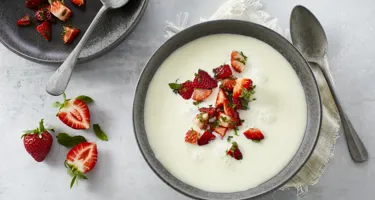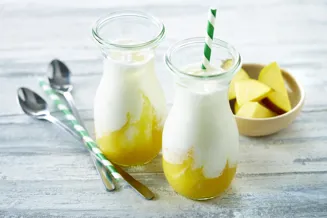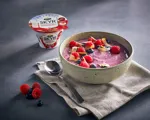
Kefir is a fermented milk drink, known for its subtle effervescence due to the bubbles formed during fermentation. Because of its tangy flavour and creamy texture, it can be used for a wide array of dishes.
It is typically used to freshen up everything from smoothies and shakes to salad dressings, sauces, and marinades. The slight fizziness adds a distinct twist, making it even more enjoyable when consumed as a beverage on its own.
How to make kefir?
Kefir is made by fermenting milk with cultures that include a mix of lactic acid bacteria and yeast, characteristic of kefir. This fermentation gives the kefir its fresh and distinctive taste. During the process, the milk remains warm until the desired consistency and flavour are achieved. Once this is done, the kefir is cooled and prepared for packaging.
A distinct trait of kefir is the production of carbon dioxide by the living cultures, resulting in a slight fizz when the package is opened. This carbon dioxide presence also imparts a slightly sparkling or tingling sensation in the mouth when you drink it.
What is water kefir?
Water kefir is a lactose-free alternative to the traditional kefir. Instead of milk, a mixture of water and sugar is used as the liquid base. Water kefir grains are different from the ones used for the milk version. These grains are translucent and with a gel-like structure, but they work in the same way.
If you want to make homemade water kefir, dissolve sugar in water and add flavours such as dried fruits, citrus zest, or spices if you desire, and then ferment for 24-48 hours. Strain and refrigerate. This type of grain can also be saved if you want to make more batches later.
What is the difference between kefir and yogurt?
The main difference between kefir and yogurt is their fermentation process resulting in differences in flavour and texture. Kefir usually tastes tangier and has a fizzy texture because of the carbon dioxide processed during fermentation. This process is also the reason it has a deeper flavour profile. Also, kefir tends to be more liquid, whereas yogurt is known for its smooth and creamy consistency.
It is also possible to make kefir with a thicker consistency more akin to yogurt. The variation is called kefir yogurt or labneh. Straining the kefir removes some of the whey, resulting in a thicker consistency. It combines the tangy flavours with the texture of yogurt. If you want to know more, check out our article What is labneh?
If you want to read about more possible yogurt-like options, you might also want to look at our article What is skyr?
Can you freeze kefir?
Yes, you can freeze kefir. Just know that the texture and consistency may change slightly, as freezing can cause it to separate when thawed. Store in an airtight container in the freezer. To thaw, let it do so slowly in the fridge overnight.
How long does kefir last?
Kefir can last about a day or two if freshly fermented. If stored in the fridge, its shelf life will increase to 1-2 weeks. Freezing it will make it last for 1-3 months.
When to drink kefir?
With similarities to yogurt, kefir is a great and easy breakfast option. However, it also works wonders as a simple grab-and-go snack at any time of day.

Can you cook with kefir?
Yes, you can cook with kefir. Use it as a base for creamy sauces and dressings or as a substitute for ingredients like sour cream or mayonnaise. It will add a dose of tanginess while maintaining a creamy consistency.
It is a very versatile ingredient going with meals and dishes at any time of the day. If snack time is calling, try blending it with fruits and vegetables to make fresh smoothies and shakes of your choosing. For dinner or lunch, a dressing, marinade, or sauce with a kefir base is easy to make. Main courses such as soups and stews can easily benefit from a dose, while baked goods and desserts tend to thrive with a tangy touch.
How to flavour kefir
Berries and fresh fruits such as sliced peaches, mangoes, or bananas go well with the tangy kefir, while honey or maple syrup also give the drink a nice sweetness.
Some like to mix it with vanilla extract or spices like cinnamon or cardamom, while cocoa powder is also a popular option for those wanting a chocolaty twist. No matter what, the end results will be delicious.
It is best to add your preferred flavour or ingredient just before enjoying it, so it retains the freshness. The flavouring process is like a playground where you can try things out, so start experimenting and find out what you like best.
Is kefir high in protein?
Kefir contains 3.4 grams of protein per 100 grams, equalling an energy contribution of 5.78%, so it is not considered a high-protein product, as this requires an energy contribution content of 20%. In comparison, skyr contains 11 grams of protein per 100 grams and 1.5% yogurt contains 4.1 grams.






































&format=webp)







